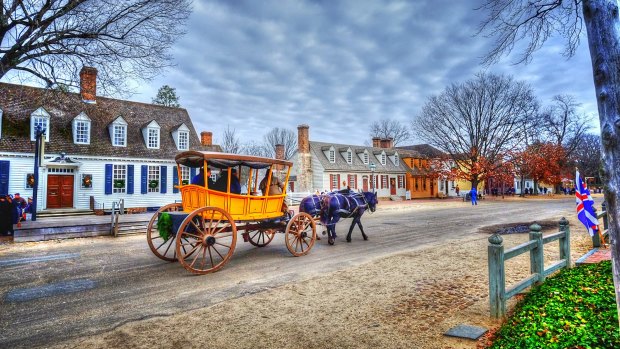
Colonial Williamsburg.Credit: L. Toshio Kishiyama
1 ARLINGTON NATIONAL CEMETERY
When US servicepeople are killed in action, they are generally buried in the Arlington National Cemetery. Sprawling over 200 acres, more than 300,000 people are laid to rest in a place that manages to be both humblingly sombre and quietly beautiful. JFK, Jackie O and Bobby Kennedy are also laid to rest there, and the Tomb of the Unknowns represents all those who remained unidentified. See arlingtoncemetery.mil
2 THE PENTAGON MEMORIAL
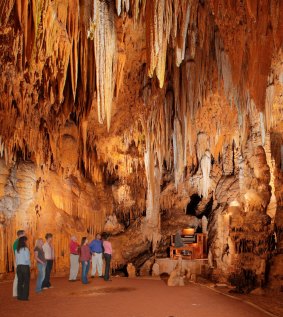
Luray Caverns' great stalacpipe organ.Credit: Mark Delsasso
Equally moving, once you navigate the Dante's Inferno-esque car parks around the Pentagon, is the memorial to those who died there on September 11, 2001; 184 benches represent those killed either in the US military HQ or on the plane that crashed into it, while fountains bubble underneath. See pentagonmemorial.net
3 THE DEA MUSEUM
There are plenty of excellent museums across the Potomac River in Washington DC, but Arlington is home to the little-known and oddly fascinating Drug Enforcement Administration Museum. It traces the War On Drugs, and the influence of narcotics in US society, right back to the 19th-century Opium Wars in China. The timeline approach also covers cocaine being marketed as a magical cure-all, the beat poet-led drugs resurgence in the late '50s and the brutality of the Colombian cartels. See deamuseum.org
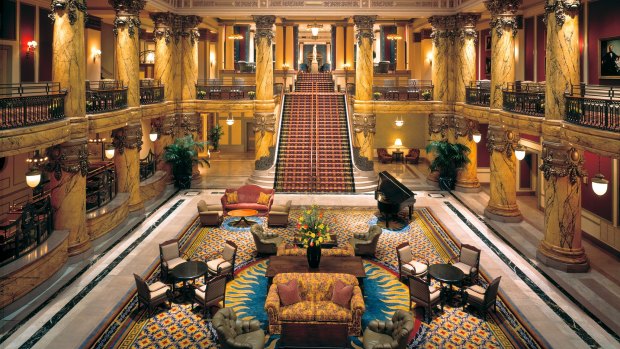
The historic Jefferson Hotel. Credit: Virginia Tourist Board
4 OLD TOWN ALEXANDRIA
Alexandria's Old Town is a marvellously handsome place of red brick buildings, stars and stripes flags and historic taverns. The waterfront has prettified enormously from when it was a major port, and the former torpedo factory is now a massive arts centre where dozens of local creative types have their studios. King Street is the star, though, lined with seemingly hundreds of pubs, restaurants and boutiques. See torpedofactory.org
5 COLONIAL WILLIAMSBURG
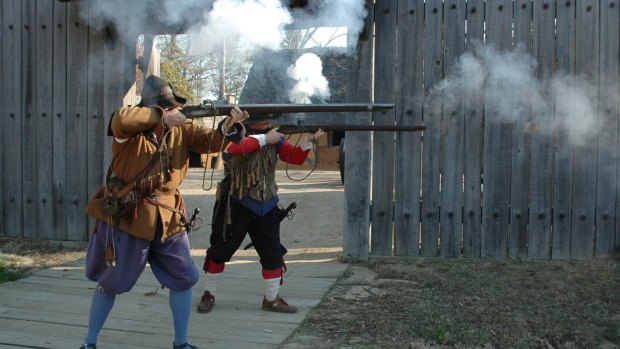
Jamestown Settlement, a museum of 17th-century Virginia history, explores America's first permanent English colony through film, galleries and living history in outdoor re-creations of a Powhatan Indian village, three English ships and colonial fort, and seasonal riverfront discovery area.Credit: Jamestown-Yorktown Foundation
The sheer scale of Colonial Williamsburg – the former capital of Virginia that has been maintained as it was where possible and restored where not – is astonishing. It now acts as a gigantic open-air museum, full of blacksmithery demonstrations, in-character talks, horse and carriage rides and other such wholesomeness. The execution and colossal ambition of the project makes it several degrees better than it sounds. See colonialwilliamsburg.com
6 JAMESTOWN ★
Just a few miles away from Colonial Williamsburg, Jamestown was the site of the first British settlement in the Americas in 1607 – and its eventual success changed the course of North American history forever. Of the two attractions there, Historic Jamestowne is on the original site and is more focused on the archaeology. The Jamestown Settlement is just over the river channel, and is a bigger, flashier and more impressive museum – especially when it comes to the open-air aspects such as the reconstructions of the ships that brought the initial settlers over. See historicjamestowne.org and historyisfun.org/jamestown-settlement
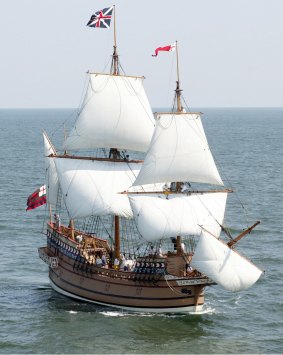
The Susan Constant under sail. Jamestown Settlement Credit: Virginia Tourist Board
7 YORKTOWN
The third leg of the heavily marketed "historic triangle" is Yorktown. This was where the British surrendered at the end of the Revolutionary War, guaranteeing American independence. Alongside museum-style exhibits about the revolution, the army encampments and a reconstructed farm from the era pad out the entry fee value. See historyisfun.org/yorktown-victory-center
8 CHARLOTTESVILLE
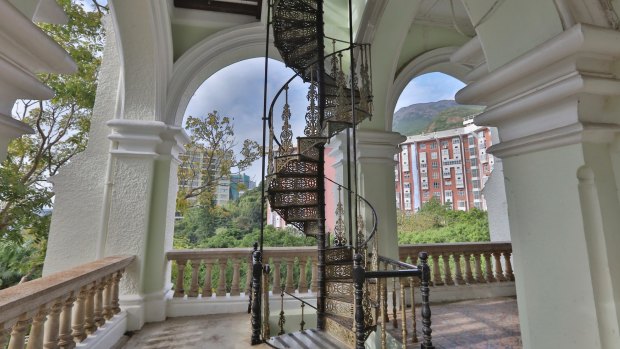
The main entrance stairs of university hallCredit: seaonweb
A happily liberal pocket in the west of the state, and in the foothills of the mountains, Charlottesville is dominated by the University of Virginia. But it's a college town of just the right size, and with enough other business to provide Charlottesville with an exceptional per-capita number of restaurants, craft beer bars and live music venues. The US Bureau of Economic Research named it the happiest place in the country last year – and it's not difficult to see why. See visitcharlottesville.org
9 MONTICELLO ★
The University of Virginia was created by Thomas Jefferson, the third US president and author of the Declaration of Independence. His rather gorgeous mountain-top home is a few miles outside the city, and there's so much more to it than old furniture. Jefferson was a polymath, who collected books, wine and assorted oddities voraciously. Many of his maps, native American artefacts and animal trophies are on display at Monticello. But it's the tours – and the barrage of tales about a highly complicated, contradictory man – that make it fascinating. See monticello.org
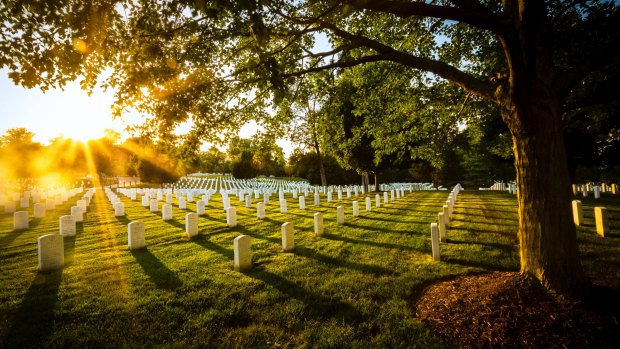
A late afternoon walk in Arlington Cemetery, where more than 300,000 people are buried.Credit: Marc Perrella
10 MOUNT VERNON ★
Gorgeous in a very different way, George Washington's less lavish family home occupies a wonderful spot overlooking the Potomac River. The gardens and grounds – including the slave quarters and Washington's tomb – are more interesting than the house itself. But the on-site museum is the most absorbing part, exploring the man who set many precedents as a fairly reluctant president who helped make the US what it is today. See mountvernon.org
11 MORE PRESIDENTS' HOMES
If that's not enough presidential insight for you, there are plenty of other presidential homes to slog around. John Tyler's Sherwood Forest and William Henry Harrison's birthplace, the Berkeley Plantation, are near each other along the James River. James Monroe's Ash Lawn-Highland and James Madison's Montpelier further west are also open to visitors, while Woodrow Wilson's birthplace in Staunton is also home to his presidential library. See sherwoodforest.org, berkeleyplantation.org, ashlawnhighland.org, montpelier.org, woodrowwilson.org
12 WINE TASTING
California may be the big beast when it comes to wine, but Virginia is giving it a decent run for its money. The number of wineries – mostly in the west around Charlottesville – has boomed in recent years, and many have cellar doors open for tastings. Cabernet francs, chardonnays and viogniers are the key varietals. The well-established Barboursville vineyard is a fine starting points. See bbvwine.com
13 CIDER TASTING
The predictable craft beer boom has followed the wine boom but, more unusually, cider is following suit. From zero cideries 10 years ago, there are now about 16 in the west and centre of the state – and about half of them have sprung up in the last two years. Most have tasting rooms, including the relative big boy Bold Rock and family-owned Albemarle Ciderworks near Charlottesville. See boldrock.com and albemarleciderworks.com
14 LURAY CAVERNS
There are plenty of caves in the west of the state, but the Luray Caverns are on a whole different plane to the rest. It's a two-kilometre walk through, during which there are thousands of stalagmites and stalactites to see – the concentrations of them are extraordinary. Throw in some big set-piece columns and flowstone formations, and immensely picturesque reflections in subterranean lakes, and it's a photographer's dream. And then at the end there's the Stalagpipe Organ – officially recognised as the largest musical instrument in the world, and played by tiny hammers striking stalactites to play just the right note. See luraycaverns.com
15 THE SKYLINE DRIVE ★
The Shenandoah National Park takes in a good chunk of the Blue Ridge Mountains in the north-west of the state. The Skyline Drive – with four entry and exit points over 175 kilometres – snakes through the middle of it. The winding road hugs mountain ridges, providing a disgustingly greedy number of scenic viewpoints at which to pull over. Stop at them all, and you're going to be there a long time. There are also plenty of good hiking trails from the car parks. See visitskylinedrive.org
16 THE AMERICAN CIVIL WAR MUSEUM
Virginia was right at the heart of the American Civil War, with several of the key battles being fought in the state. The American Civil War Centre at the former Tredegar Ironworks in Richmond is the best single place to get to grips with it. A timeline approach is employed effectively, starting with the tensions over slavery and the US' expansion that led to the war, then going year by year along the key fronts. Everything is looked at from a Union, Confederate and African-American perspective. See acwm.org
17 MONUMENT AVENUE
The complex relationship the South has with its Civil War history is best embodied by Monument Avenue, the grandest street in Richmond. It has a series of gigantic statues down the middle, most of which are dedicated to Civil War generals in the most lionising way imaginable. They're impressive as pompous works of art, yet a little disturbing in tone. But that unease is a fine introduction to a mentality that still exists in the South.
18 JAMES RIVER RAFTING
Richmond is strategically sited on the James River, at the point where it becomes no longer possible for large boats to head further upstream. The river is delightfully wild at this point, with plenty of rocks and little islets to explore right next to the city centre. It's also the only urban setting in the US with Class IV rapids – making it brilliant for white-water rafting, tubing and kayaking. River City Adventures runs trips with all three. See rivercityadventure.com
19 HISTORIC HOTELS
Most hotels strive for one great lobby, but the Jefferson in Richmond has two. One has a giant statue of Thomas Jefferson in the middle, the other is surrounded by coloured marble-effect columns and frankly demands to have afternoon tea taken in it. The recently refurbished landmark takes up an entire block. Meanwhile, the Monaco in Alexandria has similar stalwart status, but goes for a more quirky, flamboyantly theatrical bent. See jeffersonhotel.com and monaco-alexandria.com
20 THE STEVEN F UDVAR-HAZY CENTRE ★
In Chantilly, right next to Washington Dulles airport, this is the forgotten Smithsonian Museum. It's a branch of the National Air and Space Museum and essentially features all the planes that were too big to fit in the main HQ. But the collection is eye-popping. The Space Shuttle Discovery is usually seen as the star attraction, but there's also a Concorde and a sleek black Lockheed SR-71 Blackbird – the fastest plane in the world. Try not to gulp, too, when you see the Enola Gay – the plane that dropped the atomic bomb on Hiroshima. See nasm.si.edu
The writer was a guest of the Virginia Tourism Corporation (virginia.org), the Jefferson Hotel, and the Oakhurst Inn in Charlottesville (oakhurstinn.com).
Sign up for the Traveller Deals newsletter
Get exclusive travel deals delivered straight to your inbox. Sign up now.